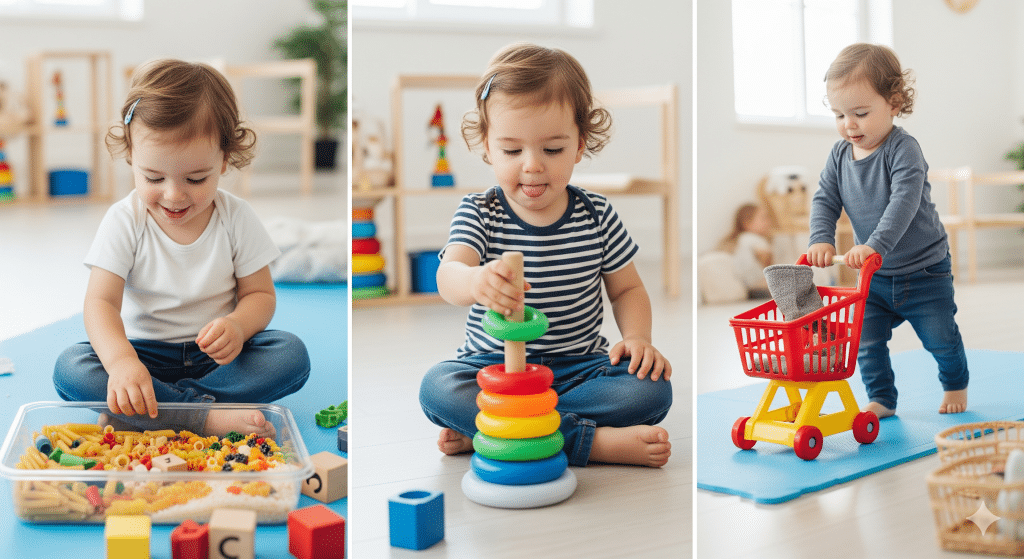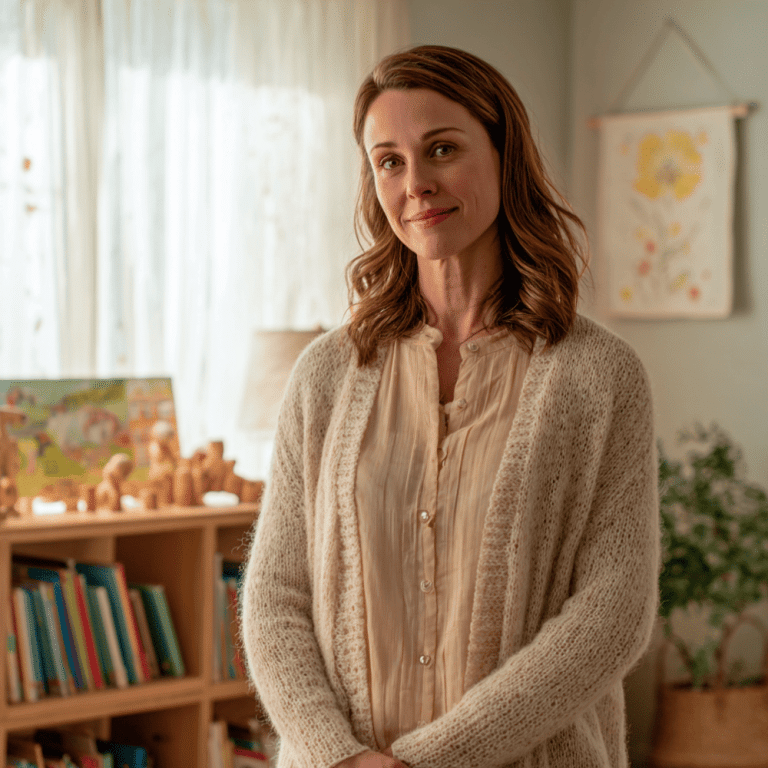Keeping a 1-year-old entertained can be tough. Their attention span is short, they’re full of energy, and safety is always on your mind. On top of that, it’s easy to run out of screen-free ideas when you’re at home all day.
I remember feeling the same way, wondering what simple things I could do to keep my child busy without stress. The truth is, you don’t need fancy toys or complicated setups.
Simple, everyday play has big benefits for learning and development. It helps with language, movement, problem-solving, and independence, all while giving you time to connect.
Let’s look at why play matters so much at this age before getting into the best activities you can try.
Why Play Matters at Age One?
At one year old, children are growing and changing fast. Play is more than just fun; it’s how they learn about the world. Simple activities support major milestones that are happening right now.
- Motor skills: Crawling, standing, walking, and picking up objects all get stronger with daily play.
- Language: Songs, stories, and conversations help them learn sounds, words, and meaning.
- Problem-solving: Stacking, sorting, and figuring out how things work builds early thinking skills.
Play also sparks independence. When a child tries new things on their own, they gain confidence and curiosity. These small steps create the foundation for learning and connecting with others as they grow.
Activities to Do With a 1-Year-Old
One-year-olds are curious to learn , and the right activities can support their growth while keeping play fun and safe.
Sensory Activities
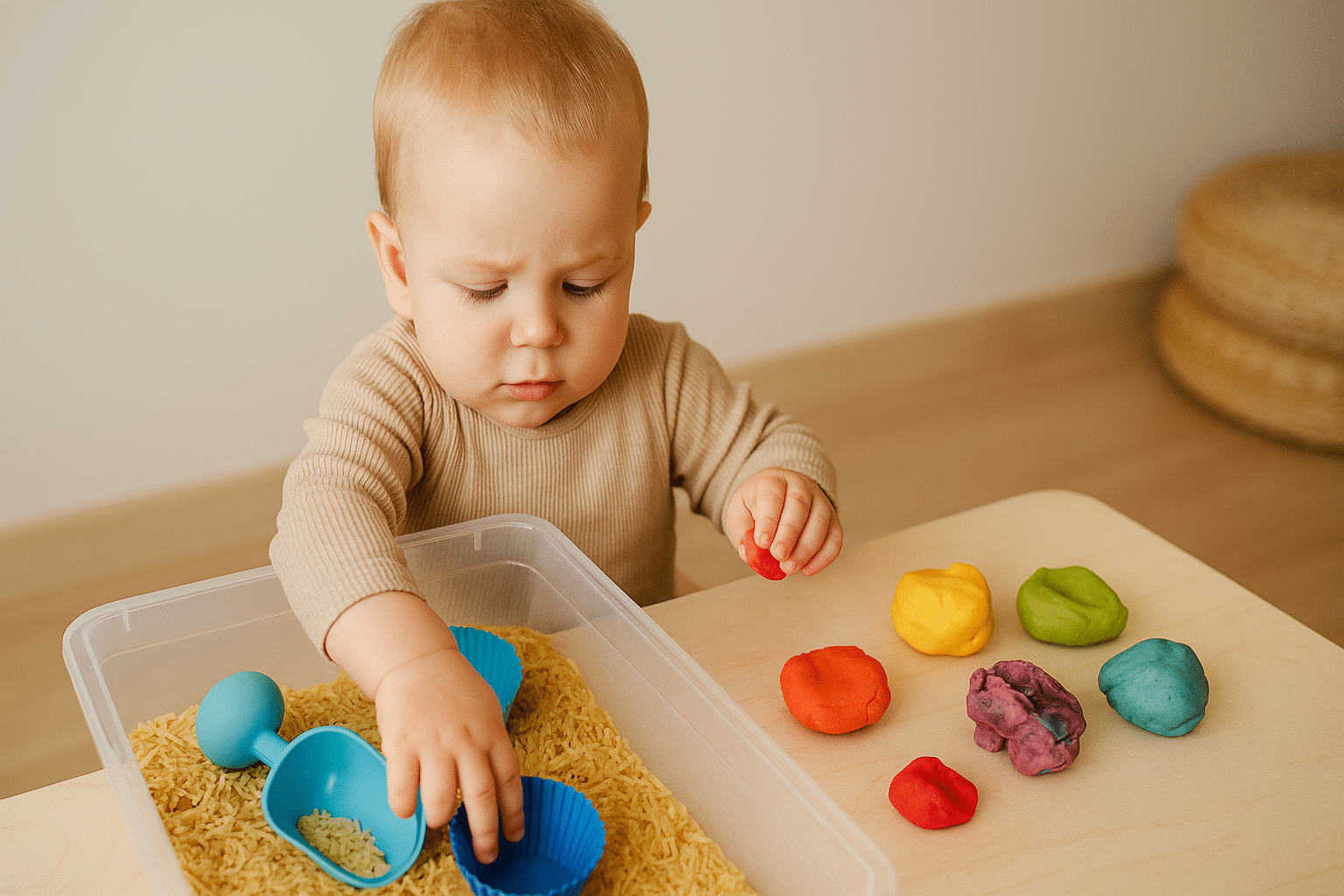
Sensory play is an activity for 1-year-olds that helps kids find textures, sounds, and colors. It builds fine motor skills while keeping their curiosity active. Below are a few simple ideas to try at home.
- Sensory Bins: Fill a shallow bin with rice, pasta, or water. Add scoops, cups, or spoons for your child to learn. Always supervise closely to prevent choking, and choose larger items if your child still mouths objects.
- Playdough & Clay: Soft dough is perfect for squishing and rolling. Use edible playdough recipes made with flour, water, and salt if safety is a concern. This activity strengthens little hands and introduces creative play.
- Mess-Free Painting: Place paper and finger paint inside a sealed plastic bag. Tape it down and let your child press and swirl the colors around. It’s a no-mess way to enjoy art and textures.
- Water Play with Cups: Fill a shallow basin with water and provide cups or spoons for scooping and pouring. It teaches cause-and-effect while building fine motor control.
- Nature Basket Learning: Gather safe items like pinecones, large leaves, or shells in a basket. Let your child understand textures and learn about the natural world.
Fine Motor Skills
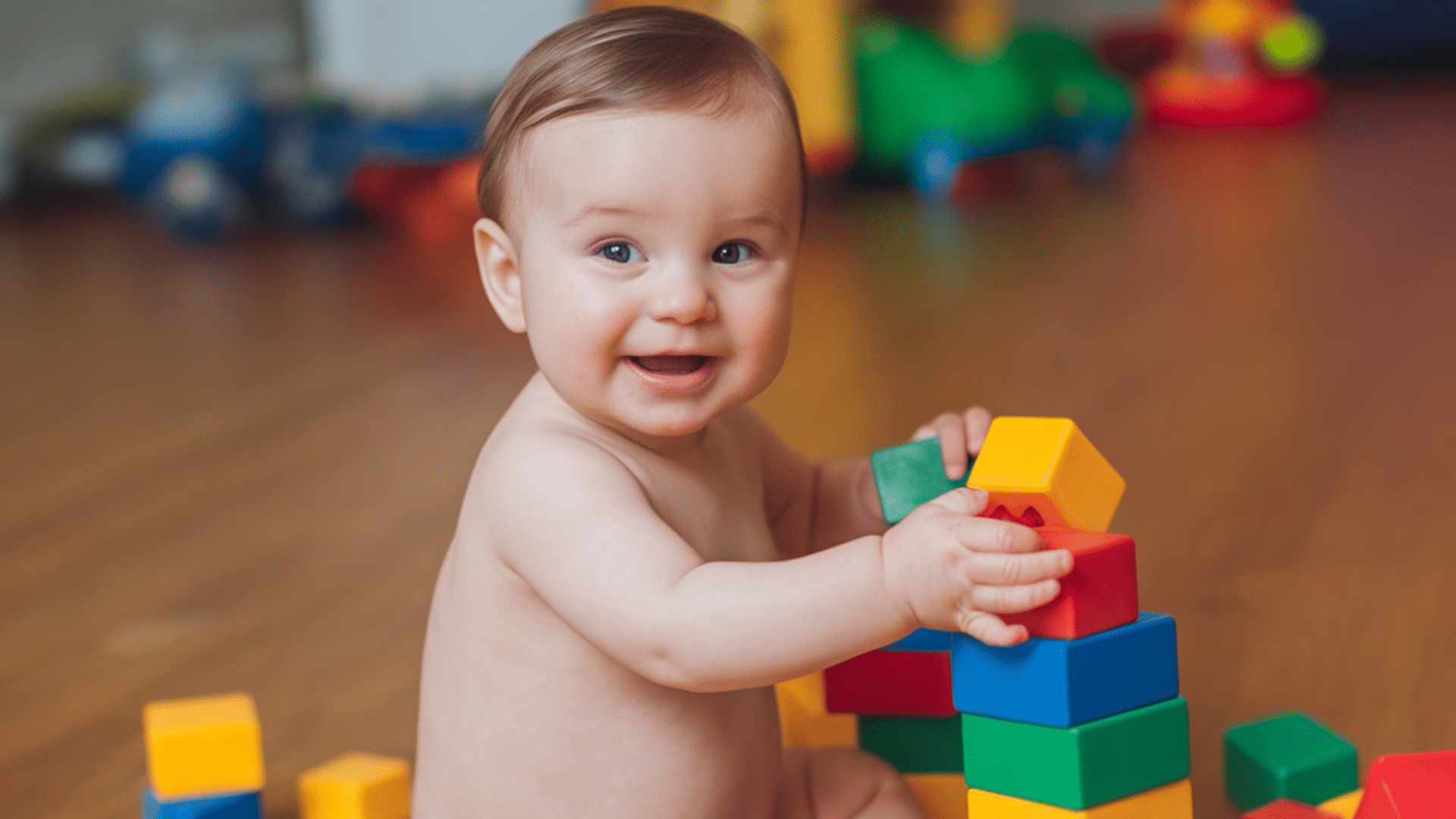
Fine motor play helps toddlers strengthen their hands, fingers, and coordination. These small movements build the foundation for writing, self-feeding, and problem-solving later on.
- Stacking Blocks or Cups: Give your child soft blocks or plastic cups to stack and knock down. This simple game teaches balance, patience, and cause-and-effect.
- Sticker Peeling & Posting Games: Peel stickers and let your child place them on paper or a safe surface. You can also set up a small box with a slit for posting cards or lids. Both activities increase finger strength and focus.
- Pasta Threading & Straw Drop: Offer large pasta pieces with a pipe cleaner or a container with holes to drop straws through. These activities improve hand-eye coordination and concentration.
- Shape Sorters & Simple Puzzles: Wooden puzzles or shape-sorting toys encourage problem-solving while building matching skills. Start with big, chunky pieces that are easy for small hands to grab.
Gross Motor Play
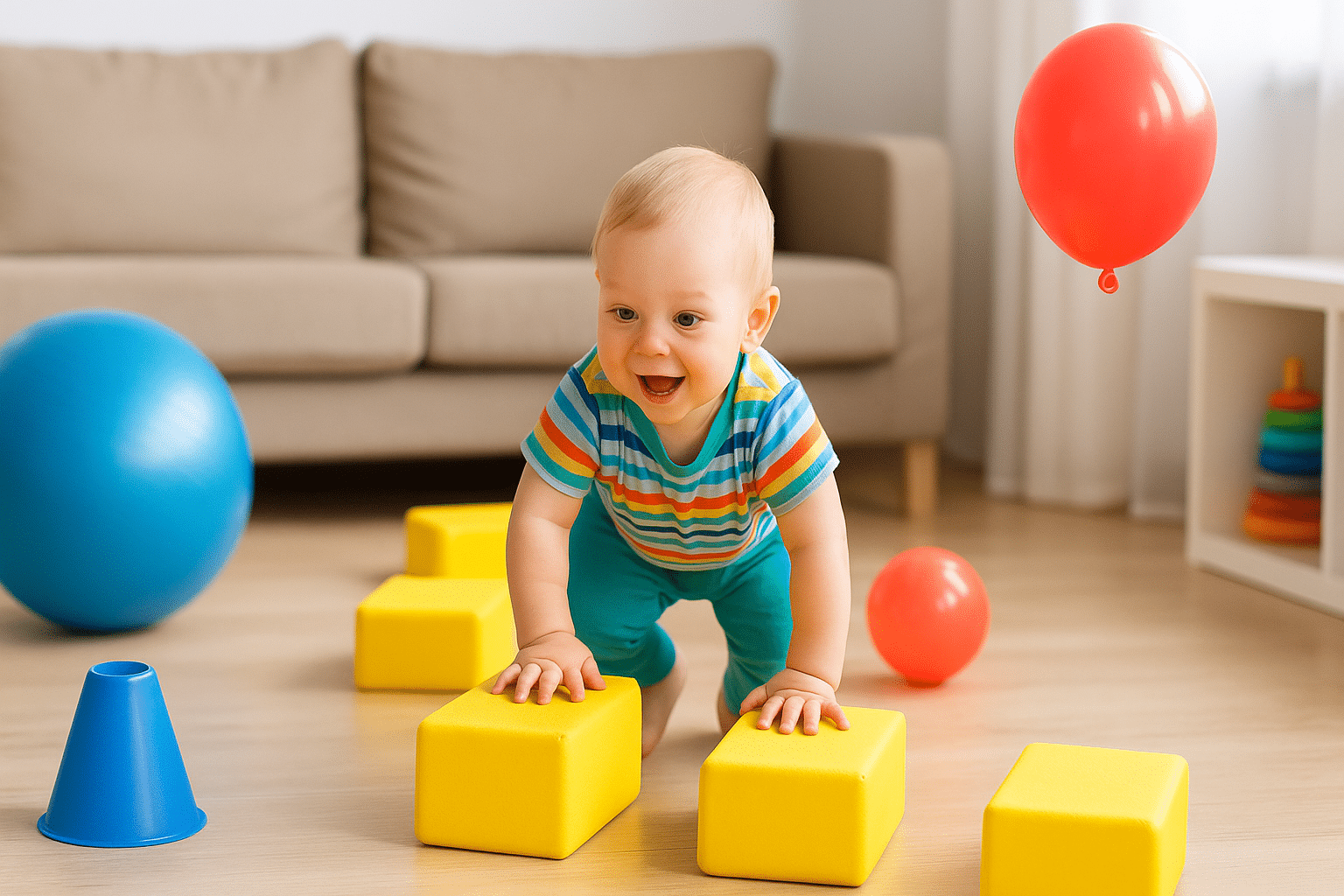
Gross motor activities give toddlers the chance to use their whole bodies. They build strength, balance, and confidence while burning energy in fun ways.
- Indoor Obstacle Courses: Set up pillows, cushions, or tunnels for crawling and climbing. This simple setup encourages movement and problem-solving indoors.
- Ball Play & Balloon Toss: Rolling, kicking, or tossing a ball helps with coordination. Balloons move slowly, making them easy for little ones to chase and tap.
- Bubble Play: Blow bubbles and let your toddler chase and pop them. This builds hand-eye coordination, gross motor skills, and keeps play exciting.
- Tunnel Crawling: Use a play tunnel or create one from a large cardboard box. Crawling helps develop muscles, balance, and coordination.
- Baby Swings & Outdoor Walks: A swing provides calming motion and a new view of the world. Short outdoor walks let toddlers remember safely while holding your hand.
- Dance and Music Movement: Turn on the music and move together. Dancing builds rhythm, balance, and joy while strengthening the bond between you and your child.
Language & Cognitive Development
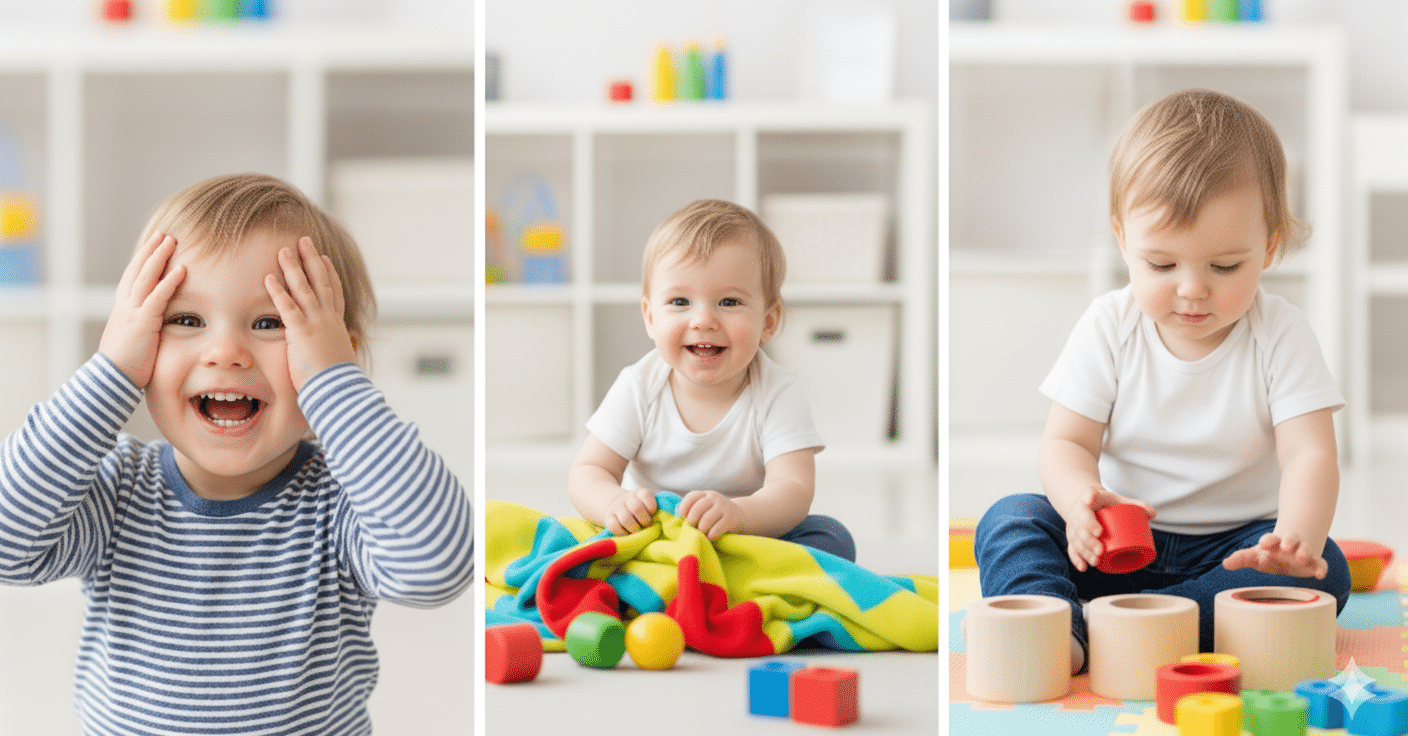
Play is one of the best ways to build language and thinking skills at this age. Simple games and routines help toddlers understand words, memory, and problem-solving.
- Reading and Puppet Play: Read short, colorful books and use finger puppets to bring stories to life. This keeps your child’s attention while building vocabulary.
- Nursery Rhymes & Songs: Singing teaches rhythm and repetition. Rhymes also make it easier for toddlers to remember new words and sounds.
- Peek-a-Boo & Hide-and-Seek: These classic games help toddlers learn object permanence and memory. They also bring joy and encourage social interaction.
- Sorting and Matching: Use toys, socks, or household items to group by color or shape. Matching games introduce early logic and build attention skills.
Creative & Imaginative Play
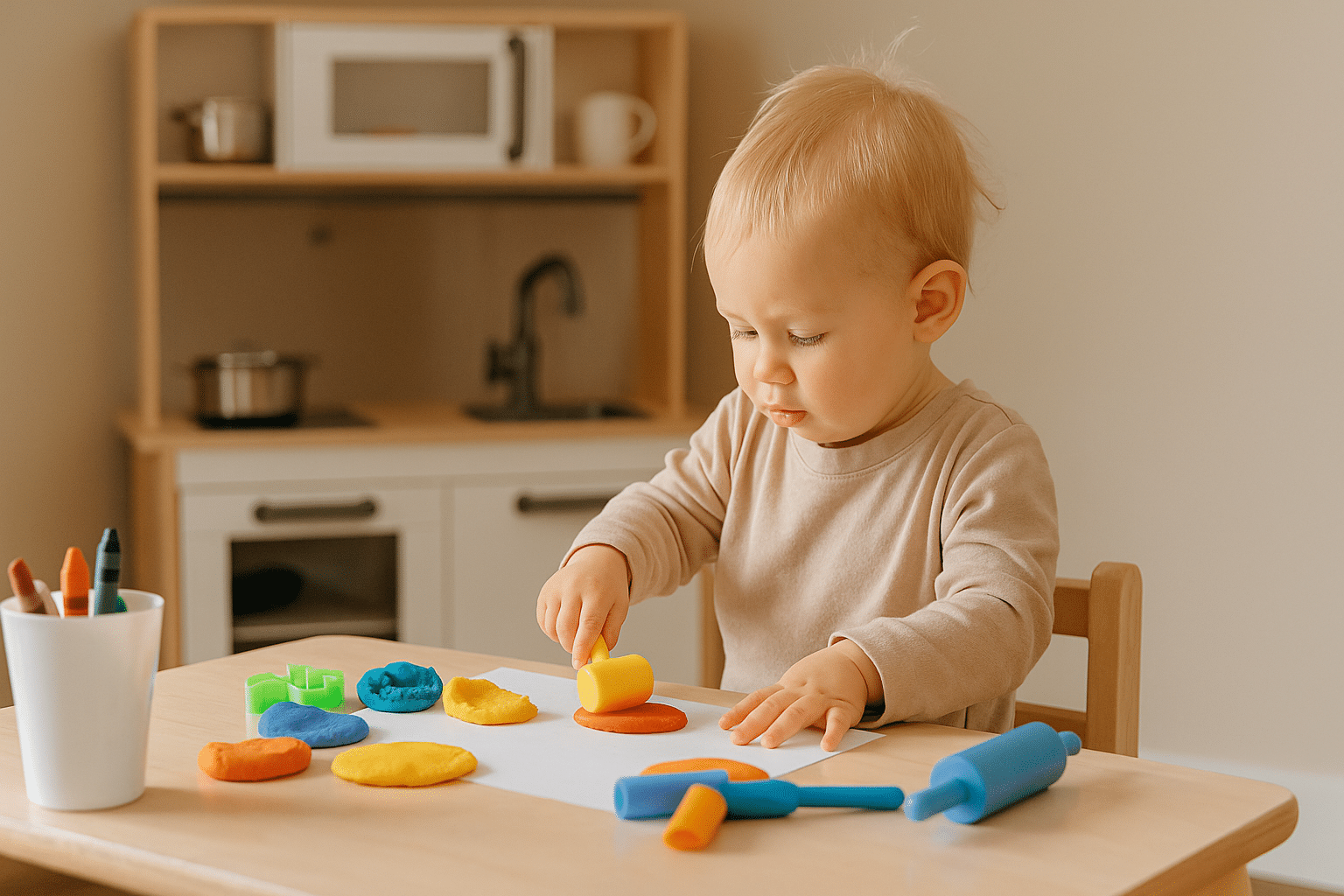
Creative play lets toddlers express themselves while learning how things work. It sparks curiosity and builds early problem-solving skills.
- Arts and Crafts (Safe Materials): Offer large crayons, washable paints, or chunky brushes. Keep projects simple and safe, focusing on colors and shapes instead of neat results.
- Pretend Kitchen Play: Give your child safe utensils, bowls, or toy food. Pretend cooking encourages imagination and lets them copy everyday routines.
- Magnetic Tiles & DIY Busy Boards: Magnetic tiles help toddlers learn building and shapes. A DIY busy board with latches, knobs, and switches gives hands-on fun and fine motor practice.
- Contact Paper Collage: Stick clear contact paper sticky-side up on a wall or table. Provide tissue paper, leaves, or fabric scraps to press down. It’s simple, mess-free, and creative.
Practical Life / Montessori-Inspired
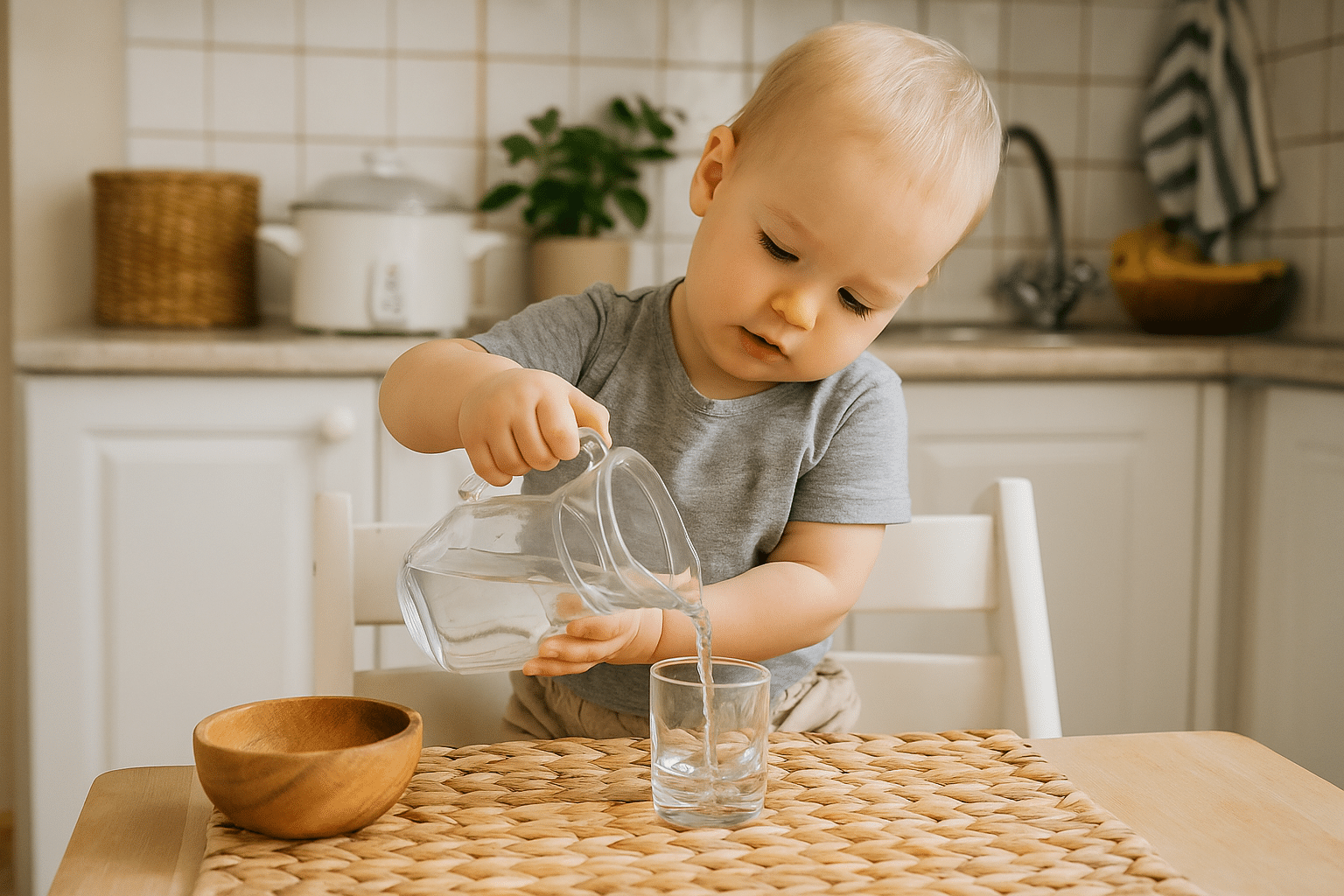
Montessori-style activities help toddlers build independence and confidence. These everyday tasks also improve coordination and focus.
- Helping with Chores: Give your child a small cloth to wipe surfaces or a tiny broom to sweep. Simple chores make them feel involved and capable.
- Pouring Water: Use a small pitcher and cup to practice pouring. Expect spills, but this builds hand control and patience.
- Posting Activities: Create a mailbox game by cutting a slot in a box. Let your toddler “post” cards, lids, or paper. This activity is fun, repetitive, and great for coordination.
- Push-and-Pull Toys: Offer a sturdy push walker or pull-along toy. These support walking skills and build confidence with movement.
Routine Integration
A simple routine helps toddlers stay settled and makes daily tasks easier to manage.
In the morning, try reading, a short walk, or sensory play. Around midday, offer free play with blocks or puzzles before lunch and nap.
In the afternoon, choose outdoor play, dancing, or a craft. Evenings work well for quiet play, songs, or storytime. Use both free play and structured play. Guided activities teach skills, while open play lets toddlers practice and learn.
For busy times, keep short options ready. A balloon toss, sticker peeling, or a quick rhyme can keep a child engaged for minutes.
Safety & Tips for Children
Safety is the most important part of play at this age. A few simple steps can keep activities fun and worry-free.
- Supervision: Always stay close during play. Even simple activities can be unsafe if a child is left alone.
- Choking Hazards: Avoid small objects like beads, coins, or tiny blocks. Use larger items that can’t fit fully in the mouth.
- Age-Appropriate Toys: Choose toys labeled for 12 months and up. Pick sturdy, non-toxic materials without sharp edges. Household items are fine if they’re safe and too big to swallow.
1-Year-Old Activities: Budget-Friendly Ideas
You don’t need to spend much to keep a 1-year-old engaged. Many fun activities can be set up with items you already have at home.
| Idea | How It Works | Benefit |
|---|---|---|
| Activities with Household Items | Use pots, pans, wooden spoons, or plastic containers for banging and stacking. | Keeps toddlers busy with items already at home, no extra cost. |
| Recycled Materials | Cardboard boxes, paper tubes, and safe containers become tunnels, blocks, or sorting bins. | Encourages creativity while reusing everyday materials. |
| Free Printable Activity Planner | Provide a weekly or monthly planner for parents. | Helps keep routines fresh and takes away daily planning stress. |
Conclusion
Finding activities for 1-year-olds can be simple and rewarding when you focus on everyday play.
Music, movement, and outdoor time give toddlers natural ways to learn. These activities support language growth, motor skills, and problem-solving while keeping little ones happy and curious.
Consistency and connection matter most – just a few minutes of focused play each day can build confidence and independence. You don’t need fancy toys or complicated setups, only simple ideas that fit into your daily routine.
If you found this guide helpful, share it with other parents or leave a comment with your favorite activity idea.
Frequently Asked Questions
Do 1-year-olds need structured learning activities?
Not really. At this age, play itself is learning. Structured activities should stay short and simple, while most learning happens through daily activities.
Is screen time okay for 1-year-olds?
The American Academy of Pediatrics recommends avoiding screen time under age 2, except for short video chats. Active play is always better for development.
What are some signs my 1-year-old is getting enough stimulation?
A well-stimulated toddler shows curiosity, tries new skills, and engages with toys or people. If they seem restless or fussy, switch activities or give quiet time.


